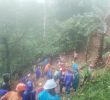“The results of the study will serve as basis in crafting the management plan for the tarsier in the region,” said DENR- 11 Executive Director Joselin Marcus Fragada.
By MARILOU AGUIRRE-TUBURAN
Davao Today
DAVAO CITY, Philippines — After the recent discovery of large colonies of Philippine Tarsier in Suaon village in Kapalong town, Davao del Norte and in Bonbon village in Mati town, Davao Oriental, the Department of Environment and Natural Resources (DENR) will count just how many tarsiers in these areas.
In a statement Monday, the DENR said it will undertake a population count of the Philippine Tarsier (Scientific name: Tarsius syrichta) and assess the natural habitats of the Tarsier in the said provinces.
“The results of the study will serve as basis in crafting the management plan for the tarsier in the region,” said DENR-11 Executive Director Joselin Marcus Fragada.
The DENR’s Protected Areas and Wildlife Division will lead the study, in coordination with the Davao Speleologial and Conservation Society, Fragada added.
The Philippine Tarsier, according to Fragada, is among the country’s wildlife species placed under a “protection” status. This means that “its sale and collection in the wild is strictly prohibited.”
In 1986, it was assessed as “endangered” by the International Union for the Conservation of Nature Conservation Monitoring Center and continues as such up to the present.
Tarsiers, according to the Endangered Species International (ESI), are haplorrhine (dry-nosed or simple-nosed) primates (a group that includes monkeys, apes and humans) that can only be found in the islands of Southeast Asia.
They are small with very large eyes, elongated hind legs and feet, a thin tail and long fingers. They are born with fur and their eyes open and can climb trees within an hour of birth.
It is said that there are three species group (Western, Eastern and Philippine) of Tarsiers with a current total 18 species and subspecies.
The Carlito syrichta species of Tarsier is said to be endemic in the islands of Bohol, Samar, Leyte and Mindanao. It occupies mainly forests and bush thickets and has also been observed in mangrove forest.
The subspecies, meanwhile, has “a very precise and limited distribution” according to ESI. The C. s. syrichta subspecies is found on the islands of Leyte and Samar; C. s. carbonariusis in the island of Mindanao and C.s. fraterculus only in Bohol.
Tarsiers are generally nocturnal, meaning they are active at night. Some species live in family groups while others spend most of their time alone.
“The majority of Tarsier species are now endangered or threatened, and some are designated critically endangered,” said the ESI. It said that the threats include: “habitat destruction and fragmentation, hunting, agricultural pollutants and human disturbance.”
ESI noted that Tarsiers do not live well in captivity as they have specific feeding requirements “which are difficult to meet and rarely successfully breed.” It also cited that wild Tarsiers which are caught and kept in captivity show around 50 percent rate of survival; and in many cases they die quickly of overstress by committing “suicide.”
“Conservation efforts should focus on their wild populations and habitats,” the ESI said. (Marilou Aguirre-Tuburan/davaotoday.com)










